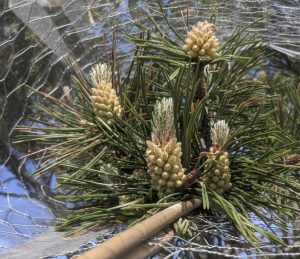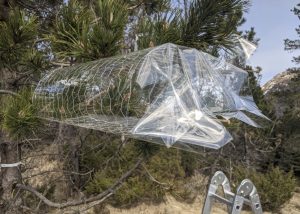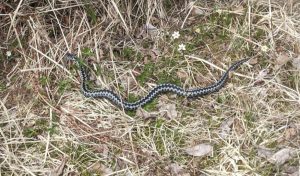By Florian Muthreich

The field season 2022 has ended for QUEST-UV, meaning that we are now processing samples for lab analysis, and even already thinking about the next field season. Here I want to reflect on the first field season of my postdoctoral research in the QUEST-UV project.
Quest-UV is interested in the effects of UV-B radiation on pollen chemistry in general, and the chemical changes of the pollen grain wall (exile) in particular. To study the effects of UV-B radiation we have two experiments. One where we manipulate the sunlight that reaches developing pollen cones on pine trees in the field; and second greenhouse experiment where we use artificial UV-B radiation to expose pine tree cuttings.

For our field experiment, we use different types of polyester sheets to filter parts of the sun’s radiation: a filter that blocks all UV radiation, a filter that blocks UV A only, a control that blocks no UV radiation but preserves the heating effect of attaching a plastic filter to a tree branch.
We adapted a design from our project partners in Finland (Matt Robson and Adam Bloch) and started building prototypes in different sizes and testing out a couple of ways to attach the filters to the trees. In the end we used a bamboo stick to straighten out the branches and attach the filters to it. We went into full production and produced ~60 filters, by bending chicken wire into tubes and attaching the plastic sheets to them.

We were lucky with the spring weather this season, with a lot of sun during March and April, and were able to attach all the filters before snowmelt. The goal was to get the filters in place, before the pollen cones begin their development and receive any sunlight. Our field site is a short drive from Bergen followed by a short hike to a hillside in Bontveit with a nice view of Gulfjellet and the surrounding mires and forests. In good weather there is a good chance to encounter some “Hoggorm” (common adder, Vipera berus) on the way to the field site, as I did several times. The only thing to watch out for is ticks, as they are plenty and eager to find a new host.
By the end of the second week, I knew the drive and the surrounding area very well and I would visit the site very other day during the coming weeks, monitoring the pollen cone development, cutting branches for the greenhouse experiment and in the end sampling the matured pollen. There were three of the filters that needed fixing, because the wind had ripped the plastic. In the end, I collected well over 70 samples of pine pollen that I look forward to analyze in the lab during the autumn.
It was an fantastic experience to follow the development of the pollen cones. I look forward to the coming season and possibly expanding our research on pine pollen chemistry into new directions.
